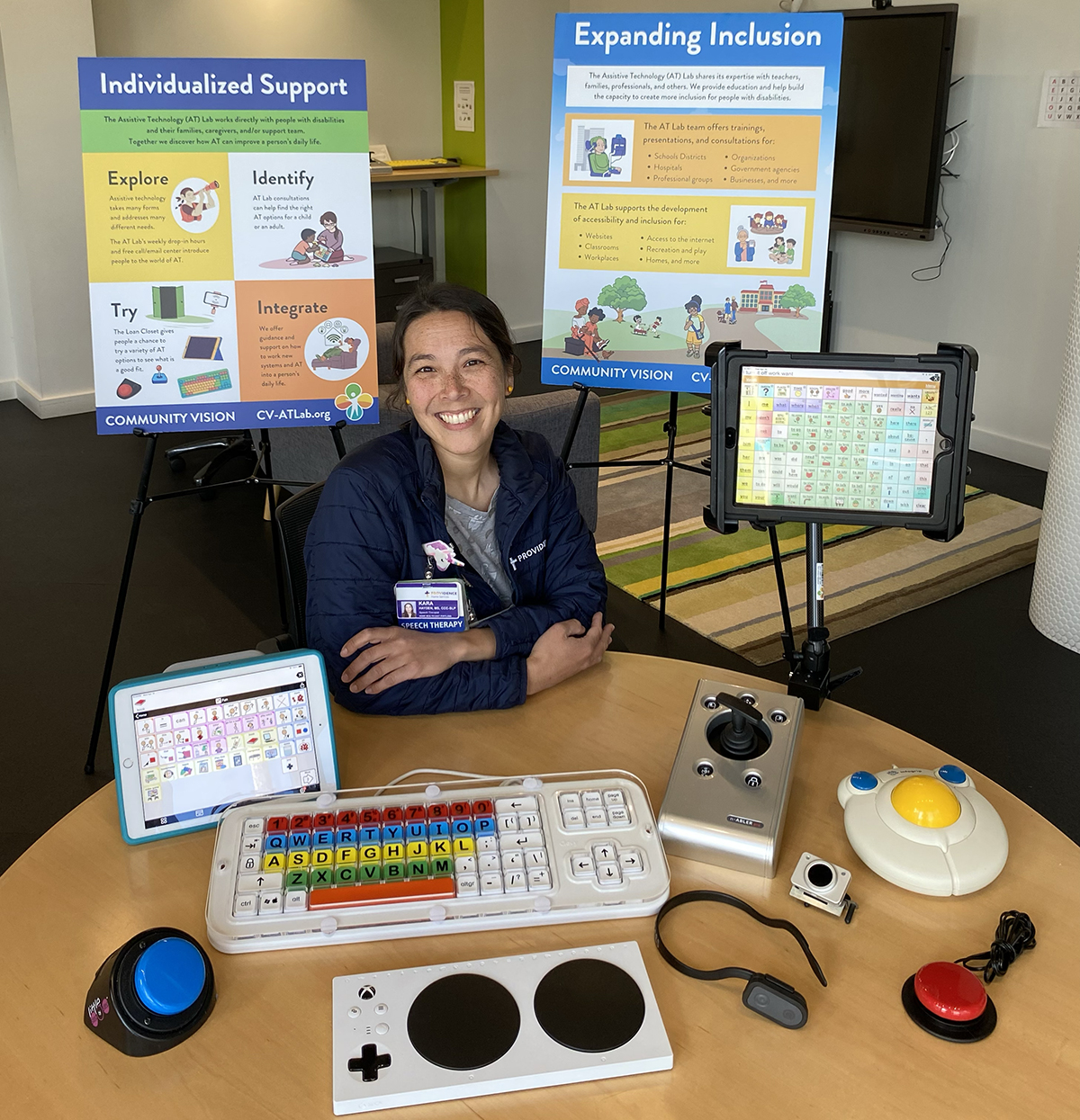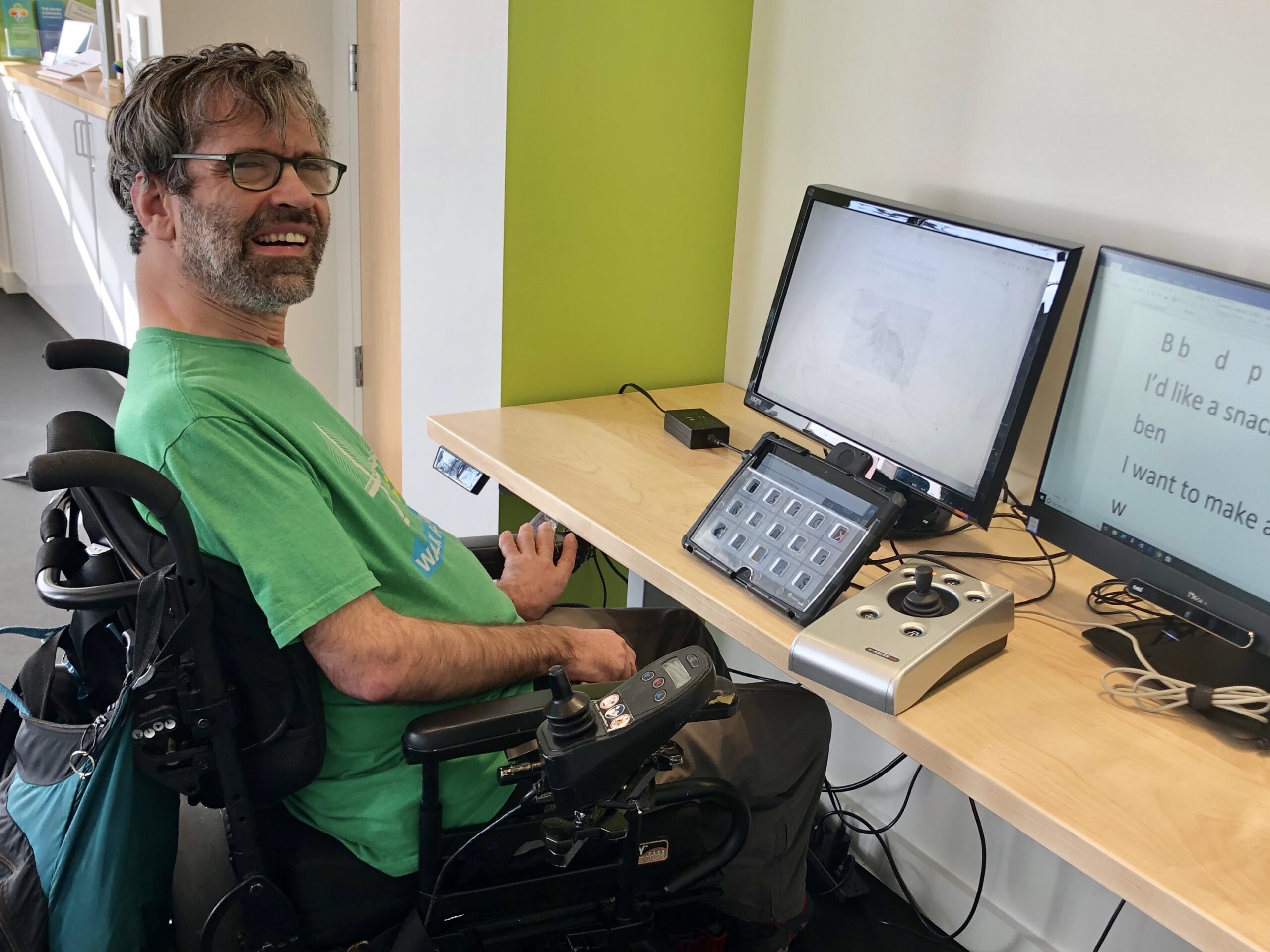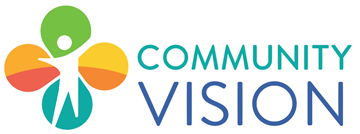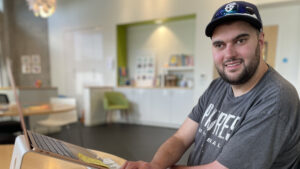AT Lab Loan Closet Fills a Gap

Assistive technology (AT) creates a bridge between what a person wants to do and what they can do. AT can be any kind of device or tool that helps a person with a disability participate in life and live with more independence.
AT can be a stylus or a head mouse that you use with your computer. It can mean having a speech generating app on an iPad. It can be using a specialized controller for playing video games. Or it can be so many other things.
However, it can be hard to find the right kind of assistive technology for a specific person. AT can be expensive and complicated. In addition, it’s not available to try out at the store.
That’s where the AT Lab Loan Closet comes in.
The Loan Closet opened in April 2020. And yes, there is a real closet in the AT Lab that holds the inventory. Community members can borrow a large selection of assistive technology from the Loan Closet for a two-week check-out period.
This lets people try several AT options. They get to test the AT in the places where it will actually be used. Based on this real-world experience, a person can decide what technology is best for them.
The Loan Closet offers a wide variety of AT, including:
- iPads with communications apps installed on them
- Specialized keyboards and mice, including eye-gaze devices, ergonomic mice, and trackballs
- A large selection of mounts for communications devices and other AT
- A variety of switches and joysticks
- Adaptive gaming accessories
- Various kinds of smart home technology
- And much more
The Loan Closet is open to community members as well as healthcare professionals.
AT Lab wants to support a person’s successful use of AT for the long-term. That requires more than just finding the right equipment. The person who uses AT and their support team need to understand how it fits into daily life and a person’s routine. That might require new skills, adjustments, practice, and follow-up.
The AT Lab offers training and consultations to individuals, families, groups, healthcare providers, and businesses. Staff are available for questions and follow-up. The Lab also has Public Open Hours on Thursdays noon–5 p.m.
Loan Closet Helps Healthcare Professionals
Kara Hayden works as a speech language pathologist (SLP) for Providence Home Health in Portland. She frequently borrows assistive technology from the AT Lab Loan Closet for her patients. She appreciates how the Loan Closet helps her help her patients:
“Most insurance will not cover a lot of simple, important AT. Community members, including providers, often don’t have access to trial different AT to determine what will work best for them or for their clients. Our local AT Loan Closet at Community Vision fills this gap so people can make informed decisions.”
Every state has an AT lending closet. They were created and funded by the federal Assistive Technology Act. Oregon’s AT lending closet is in Salem. However, it does not mail equipment. That means two to three hours of driving to check out items. Plus, they charge a maintenance fee. The AT Lab Loan Closet, however, makes equipment available locally for free to all users and healthcare providers.
“AT Lab is a time and money saver for local providers across healthcare systems,” Kara said. “It can be very difficult to gain access to basic AT to trial with patients. We use the AT Lab Loan Closet frequently so that our people can try before they buy, and we can make informed decisions together.”
Finding the Best AT Options

People use the Loan Closet for a variety of reasons. Some come because they want to succeed at work. Ben came to the AT Lab through vocational rehabilitations services. He wanted to improve his ability to communicate at his job. That meant trying a communication device and some accessories.
Ben has some challenges using his fingers. He uses a joystick to drive his wheelchair. So, the AT Lab suggested he try a joystick with the communication device. If he liked how that worked, the AT Lab could work with his wheelchair vendor to integrate the wheelchair joystick with the communications device.
Ben also borrowed a keyguard to use with the communication device. A keyguard is a piece of clear plastic with holes that overlays a speech generating device. It supports the use of touch with the device, guiding a person’s finger to the correct target.
In the end, Ben decided that he liked using his finger and the keyguard with the communication device. He was so happy to be able to take all these items home and really try them out. This way he decided on which assistive technology worked best for him before buying it.



